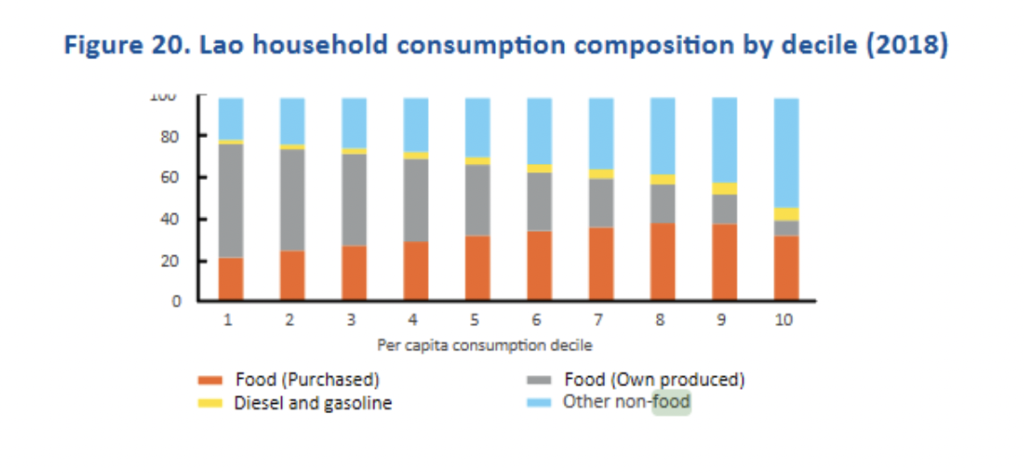Rising fuel and food prices are undermining both purchasing power and poverty reduction. While domestic labor market conditions are expected to improve gradually, long-term job losses and business closures induced by COVID-19 measures continue to put pressure on household incomes. In addition, rising food and fuel prices are undermining household purchasing power and food security. Without adequate relief measures, many families will be at risk of falling into poverty.
Rising inflation threatens living standards, especially in low-income urban households. Rising prices have been a major concern for Lao households since early 2021. In the October/November 2021 survey, 38 percent of households identified increased prices of necessary goods as the most pressing issue the government should address, up from 33 percent in February/March 2021. However, the immediate impact on poverty is expected to be moderate, as most low-income households rely on own-produced food. An increase in agricultural input prices will compromise agricultural production, even own-produced food, and income in the medium term. While fuel accounts for an average of about 5 percent of total consumption, the magnitude of the price increase and the exchange rate pass-through effect are expected to take a toll on households. Low-income urban households that rely heavily on purchased food are expected to be hit hardest.

In the absence of debt relief, meeting public debt service obligations will remain very challenging. Fiscal space is constrained by low revenue collection and the high debt service burden. Public external debt repayments (i.e., interest and principal) will average around $1.3 billion a year for 2022–25, about half of projected total domestic revenue. Fast and effective implementation of revenue-enhancing measures, coupled with a positive outcome from the ongoing debt renegotiations with key creditors, could create much-needed fiscal space for growth-enhancing expenditure.
Policies to address macroeconomic vulnerabilities should be coupled with mitigation measures to help households navigate the impacts of the COViD-19 pandemic. These include boosting agricultural production and strengthening the food supply chain. In particular, facilitating rural-to-urban agri-food chains would help mitigate the impact of price increases on the urban poor. Furthermore, facilitating job matching and migration to provinces where jobs are available and to neighboring countries would help workers return to the labor market. International remittances usually act as a mechanism for coping with income shocks, for example, because of price increases.
Agricultural value chains face critical challenges to maximize their efficiency, competitiveness, and potential for growth. Agriculture value chains are fragmented and characterized by weak organization, which contributes to higher transaction costs and lower profitability, incomes, and quality of jobs. In general, agricultural value chains have large numbers of isolated producers, poorly capitalized intermediaries and processors, and relatively few agribusinesses with the capacity to invest in improved technologies (including digital and other innovations), modern production infrastructure, and processing equipment. Consequently, all segments of the value chain (production, aggregation, processing, and distribution) lack organization and scale, limiting commercialization and realization of higher agricultural incomes. The absence of formal commercial relationships among value chain actors has led to farmers, agribusinesses, and intermediaries (traders, marketers, transportors and logistics entities) being unable to effectively link to one another to gain access to markets and transfer the knowledge and innovations necessary for improving quality and adding value domestically.
Agricultural value chains are not well organized to comply with safety standards for participation in trade protocols with major trading partners. Farmers and producers are not able to follow good quality and phytosanitary standards due to
-
limited capacity and knowledge;
-
lack of full adoption of Good Agriculture Practices and organic farming, and overuse of chemicals in farms;
-
challenges and high costs for local authorities and some buyers to provide training and have producers adopt recognized agricultural standards due to fragmented and small-scale farming;
-
insufficient training and technical extension services by agriculture departments.
Compliance with international food safety standards and traceability remain critical factors to expand agriculture exports, including to China. Support to smallholder farmers to mitigate the impact of the pandemic has been limited, especially for exports of fresh agricultural products to neighboring countries such as China in late 2021.
| Year of publication | |
| Geographic coverage | Lao People's Democratic Republic |
| Originally published | 13 May 2022 |
| Related organisation(s) | World Bank |
| Knowledge service | Metadata | Global Food and Nutrition Security | Food security and food crisesCOVID-19 and Food and Nutrition Security | Food price crisis |
| Digital Europa Thesaurus (DET) | economic conditionspovertymacroeconomicshouseholdsocial protectionvalue chainfood safetyFoodExport |
